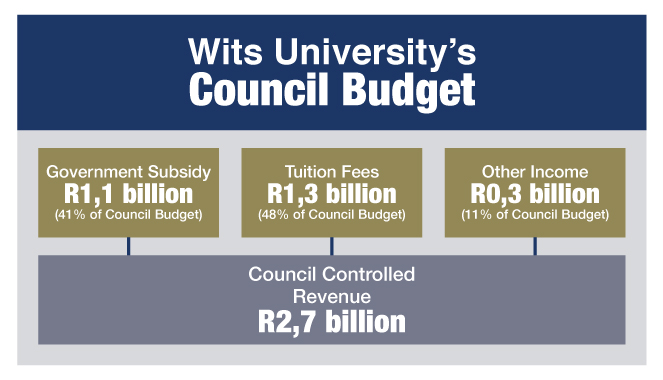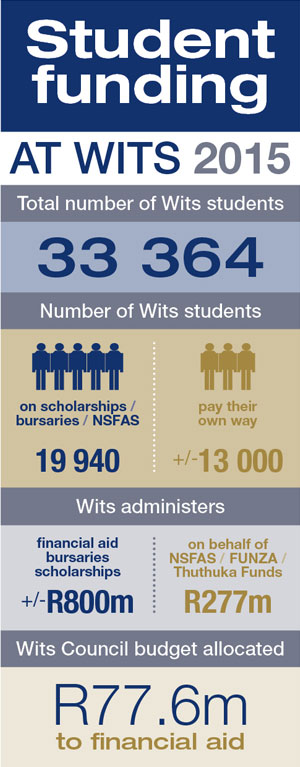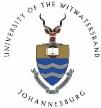Student funding explained
21 October 2015
Wits University has received numerous requests for explanations on Wits’ finances and funding model. The University’s Chief Financial Officer, Linda Jarvis, explains the funding model.
Q: Why is government subsidy not enough to fund Wits’ activities?
A: The funding from the state for 2016 is expected to increase by 5% to R1,2 billion. Higher education inflation is much higher than that of the normal Consumer Price Index and the subsidy increase is insufficient in this regard. The rand has depreciated by 22% in the past 12 months, making it more expensive to procure imported library books and electronic journals, laboratory equipment and consumables, ICT and licence fees. Municipal utilities contribute significantly to the cost structure of the University and continue to increase much higher than CPI. Academic salaries will increase by 7% and professional, support and administrative staff by 6%, as per a three year agreement.
Q: What are Wits’ main income streams?
A: Wits strives for a breakeven budget, so unlike a corporate the University does not make a profit. The University’s main income streams are from government subsidies, tuition fees and third stream income. Together, they make up the University’s Council budget.
 Council Budget
Council Budget
The Council Budget refers to funds under the control of the University Council utilised for education purposes. These funds pay for the operational expenditure of the University including staff salary costs (62%) and operational costs (38%).
Restricted Research and Grant Funds
The restricted revenue is donation and grant revenue granted to the University for specific purposes and may only be utilised for the purposes intended by the donor, sponsor or grantor. This budget includes bursaries for students which are administered by the faculties and the Financial Aid and Scholarships Office. The balance of these funds are government grants for infrastructure development, clinical training and those that we hold on behalf of the new universities, as we assist them to develop. It also includes research grants funded from government and other sources. Any monies unspent in any financial year are spent in the following financial years.
Residence Funds
Residence funds may only be utilised for purposes of residences. Any surpluses generated from residences are utilised for the refurbishment and maintenance of residences.

Q: How much do the University’s investments generate?
A: The University does not have any reserve operational funds. The investments that the University does have may only be used for the purposes for which they were granted. Any revenue earned from these investments is allocated back into the same grants.
Q: What are the pressures that play a role in the fee increases?
A: It has become increasingly difficult to balance the University Council Budget on a year-on-year basis. In recent years, the government has not been able to provide inflation-linked increases in funding while expenditure, which is not within our control, is escalating at rates higher than inflation.
Some of the key examples are:
- The rand-dollar exchange rate has fallen by approximately 22%, which has resulted in a substantial increase in the amount of money that we pay for all library books, journals, electronic resources research equipment that are procured in dollars and euros.
- Salary increases for academics are set at 7% based on a three-year cycle and these increases are necessary to ensure that we retain the best intellectual minds in the country.
- Generic inflation is hovering at around 6%, which impacts on all other expenses that the University has to cover.
- Utilities are increasing at rates substantially higher than the inflation rate.
The Department of Higher Education has in the last few years been promoting the growth in student numbers and Wits has had to raise funds from donors and our reserves to match government’s funding of infrastructure. In addition, our 260 buildings – some of which are ageing – have to be maintained. The additional cleaning, electricity and depreciations costs, without the equal income growth to match these costs, are adding pressure on the budget.
Q: How much was received from NSFAS for 2015?
A: Approximately two thirds of Wits’ students are on bursaries, financial aid and scholarships, funded by more than 500 corporates, public entities, individuals, trusts and foundations (See infographic).
Wits administered about R800 million in financial aid, bursaries and scholarships in 2015 to date. This number will increase in the next quarter. This is probably one of the highest amounts dedicated to supporting students in the country.
The University administered R277 million on behalf of NSFAS, Thuthuka and FUNZA, of which NSFAS funds are R179 million. Approximately 900 students who were eligible were not awarded funding due to a shortage of funds.
Q: Besides NSFAS funding, how much did the university use from its own coffers to fund first-year undergraduate students this year?
A: The University funded 1 540 first year undergraduate students amounting to R26,5 million from Council Funding to date.
Q: What austerity measures, if any, has the University put in place to reduce expenditure and to fund next year's students?
The University has already started putting austerity measures in place in order to balance the budget, by cutting down on non-essential expenditure. Council has indicated that it has considered a number of substantive ideas and options to address the fee increase challenge.
These possible mechanisms include:
1. Austerity measures to ensure that the University’s financial resources are biased towards the academic project and improved access. All non-essential expenditure will be interrogated.
2. Discounts for NSFAS and financially-stressed students and the sourcing of additional funding from external sources.
3. Waiving the upfront fee, not just for NSFAS students, that is already a practice at Wits, but for all qualifying students.
4. The Vice-Chancellor and Principal, Professor Adam Habib, has committed that, given the context, any performance bonus that is due to him for 2015 will go towards access for deserving students.
The University will continue to engage with government with regards to addressing the identified shortfall in funding for higher education.
Professor Habib is committed to the academic project and will do what needs to be done to show his commitment to the students and the University. He has been very active in engaging with the banks on developing a funding model that will assist students to better fund their studies, as well as with the Banking Council and government to develop a global model with the banks to fund students more effectively.
Q: How much is owed by students for this year and how many students owe this money?
A: The outstanding student balance for 2015 is currently R323 million owed by 17 800 students.
Issued by Wits, 21 October 2015

